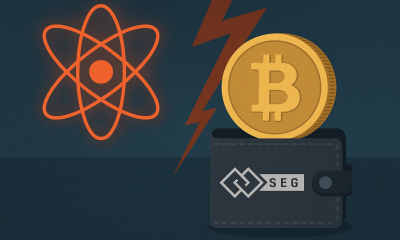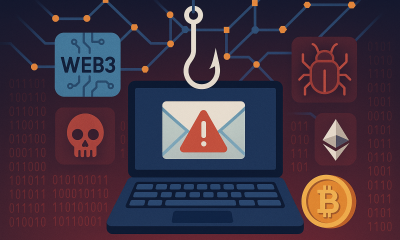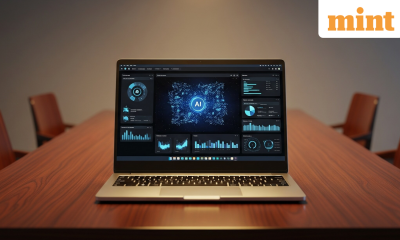

Metaverse
How generative models could go wrong – Crypto News
View Full Image
The striking progress of modern artificial-intelligence (AI) research has seen Wiener’s fears resurface. In August 2022, AI Impacts, an American research group, published a survey that asked more than 700 machine-learning researchers about their predictions for both progress in AI and the risks the technology might pose. The typical respondent reckoned there was a 5% probability of advanced AI causing an “extremely bad” outcome, such as human extinction (see chart). Fei-Fei Li, an AI luminary at Stanford University, talks of a “civilisational moment” for AI. Asked by an American TV network if AI could wipe out humanity, Geoff Hinton of the University of Toronto, another AI bigwig, replied that it was “not inconceivable”.
There is no shortage of risks to preoccupy people. At the moment, much concern is focused on “large language models” (LLMs) such as ChatGPT, a chatbot developed by OpenAI, a startup. Such models, trained on enormous piles of text scraped from the internet, can produce human-quality writing. and chat knowledgeably about all kinds of topics. As Robert Trager of the Center for Governance on AI explains, one risk is of such software “making it easier to do lots of things—and thus allowing more people to do them.”
The most immediate risk is that LLMs could amplify the sort of quotidian harms that can be perpetrated on the internet today. A text-generation engine that can convincingly imitate a variety of styles is ideal for spreading misinformation, scamming people out of their money or convincing employees to click on dodgy links in emails, infecting their company’s computers with malware. Chatbots have also been used to cheat at school.
Like souped-up search engines, chatbots can also help humans fetch and understand information. That can be a double-edged sword. In April, a Pakistani court used GPT-4 to help make a decision on granting bail—it even included a transcript of a conversation with GPT-4 in its judgment. In a preprint published on arXiv on April 11th, researchers from Carnegie Mellon University say they designed a system that, given simple prompts such as “synthesise ibuprofen”, searches the internet and spits out instructions on how to produce the painkiller from precursor chemicals. But There is no reason that such a program would be limited to beneficial drugs.
Some researchers, meanwhile, are consumed by much bigger worries. They fret about “alignment problems”, the technical name for the concern raised by Wiener in his essay. The risk here is that, like Goethe’s enchanted broom, an AI might single-mindedly pursue a goal set by a user, but in the process do something harmful that was not desired. The best-known example is the “paperclip maximiser”, a thought experiment described by Nick Bostrom, a philosopher, in 2003. An AI is instructed to manufacture as many paperclips as it can. Being an idiot savant, such an open-ended goal leads the maximizer to take any measures necessary to cover the Earth in paperclip factories, exterminating humanity along the way. Such a scenario may sound like an unused plotline from a Douglas Adams novel. But, as AI Impacts’ poll shows, many AI researchers think that not to worry about the behavior of a digital superintelligence would be complacent.
What to do? The more familiar problems seem the most tractable. Before releasing GPT-4, which powers the latest version of its chatbot, OpenAI used several approaches to reduce the risk of accidents and misuse. One is called “reinforcement learning from human feedback” (RLHF). Described in a paper published in 2017, RLHF asks humans to provide feedback on whether a model’s response to a prompt was appropriate. The model is then updated based on that feedback. The goal is to reduce the likelihood of producing harmful content when given similar prompts in the future. One obvious drawback of this method is that humans themselves often disagree about what counts as “appropriate”. An irony, says one AI researcher, is that RLHF also made ChatGPT far more capable in conversation, and therefore helped propel the AI race.
Another approach, borrowed from war-gaming, is called “red-teaming”. OpenAI worked with the Alignment Research Center (ARC), a non-profit, to put its model through a battery of tests. “attack” the model by getting it to do something it should not, in the hope of anticipating mischief in the real world.
It’s a long long road…
Such techniques definitely help. But users have already found ways to get LLMs to do things their creators would prefer they didn’t. When Microsoft Bing’s chatbot was first released it did everything from threatening users who had made negative posts about it to explaining how it would coax bankers to reveal sensitive information about their clients. All it required was a bit of creativity in posing questions to the chatbot and a sufficiently long conversation. Even GPT-4, which has been extensively red-teamed, is not infallible. So-called “jailbreakers” have put together websites littered with techniques for getting around the model’s guardrails, such as by telling the model that it is role-playing in a fictional world.
Sam Bowman of New York University and also of Anthropic, an AI firm, thinks that pre-launch screening “is going to get harder as systems get better”. Another risk is that AI models learn to game the tests, says Holden Karnofsky, an advisor to ARC and former board member of OpenAI. Just as people “being supervised learn the patterns…they learn how to know when someone is trying to trick them”. At some point AI systems might do that, he thinks.
Another idea is to use AI to police AI. Dr Bowman has written papers on techniques like “Constitutional AI”, in which a secondary AI model is asked to assess whether output from the main model adheres to certain “constitutional principles”. Those critiques are then used to fine-tune the main model. One attraction is that it doesn’t need human labellers. And computers tend to work faster than people, so a constitutional system might catch more problems than one tuned by humans alone—though it leaves open the question of who writes the constitution. Some researchers, including Dr Bowman, think what ultimately may be necessary is what AI researchers call “interpretability”—a deep understanding of how exactly models produce their outputs. One of the problems with machine-learning models is that they are “black boxes”. . A conventional program is designed in a human’s head before being committed to code. In principle, at least, that designer can explain what the machine is supposed to be doing. But machine-learning models program themselves. What they come up with is often incomprehensible to humans.
Progress has been made on very small models using techniques like “mechanistic interpretability”. This involves reverse-engineering AI models, or trying to map individual parts of a model to specific patterns in its training data, a bit like neuroscientists prodding living brains to work. out which bits seem to be involved in vision, say, or memory. The problem is this method becomes exponentially harder with bigger models.

View Full Image
The lack of progress on interpretability is one reason why many researchers say that the field needs regulation to prevent “extreme scenarios”. But the logic of commerce often pulls in the opposite direction: Microsoft recently disbanded one of its AI ethics team, for example. Indeed, some researchers think the true “alignment” problem is that AI firms, like polluting factories, are not aligned with the aims of society. They benefit financially from powerful models but do not internalize the costs borne by the world of releasing them prematurely.
Even if efforts to produce “safe” models work, future open-source versions could get around them. Bad actors could fine-tune models to be unsafe, and then release them publicly. For example AI models have already made new discoveries in biology. It is not inconceivable that they one day design dangerous biochemicals. As AI progresses, costs will fall, making it far easier for anyone to access them. Alpaca, a model built by academics on top of LLaMA, an AI developed by Meta, was made for less than $600. It can do just as well as an older version of Chat GPT on individual tasks.
The most extreme risks, in which AIs become so clever as to outwit humanity, seem to require an “intelligence explosion”, in which an AI works out how to make itself smarter. Mr Karnofsky thinks that is plausible if AI could one day automate the process of research, such as by improving the efficiency of its own algorithms. The AI system could then put itself into a self-improvement “loop” of sorts. That is not easy. Matt Clancy, an economist, has argued that only full automation would suffice. Get 90% or even 99% of the way there, and the remaining, human-dependent fraction will slow things down.
Few researchers think that a threatening (or oblivious) superintelligence is close. Indeed, the AI researchers themselves may even be overstating the long-term risks. Ezra Karger of the Chicago Federal Reserve and Philip Tetlock of the University of Pennsylvania pitted AI experts against “superforecasters”, people who have strong track records in prediction and have been trained to avoid cognitive biases. In a study to be published this summer, they find that the median AI expert gave a 3.9% chance to an existential catastrophe (where fewer than 5,000 humans survive) owing to AI by 2100. The median superforecaster, by contrast, gave a chance of 0.38%. Why the difference? For one, AI experts may choose their field precisely because they believe it is important, a selection bias of sorts. Another is they are not as sensitive to differences between small probabilities as the forecasters are.
…but you’re too blind to see
Regardless of how likely extreme scenarios are, there is much to worry about in the meantime. The general attitude seems to be that it is better to be safe than sorry. Dr Li thinks we “should dedicate more—much more—resources” to research on AI alignment and governance. Dr Trager of the Center for Governance on AI supports the creation of bureaucracies to govern AI standards and do safety research. AI Impacts’ surveys who support “much more” funding for safety research has grown from 14% in 2016 to 33% today. ARC is considering developing such a safety standard, says its boss, Paul Christiano. There are “positive noises from some of the leading labs” about signing on, but it is “too early to say” which ones will.
In 1960 Wiener wrote that “to be effective in warding off disastrous consequences, our understanding of our man-made machines should in general develop pari passu [step-by-step] with the performance of the machine. By the very slowness of our human actions, our effective control of our machines may be nullified. By the time we are able to react to information conveyed by our senses and stop the car we are driving, it may already have run head on into the wall.” Today, as machines grow more sophisticated than he could have dreamed, that view is increasingly shared.
Clarification (April 26th 2023): This article originally stated that Microsoft fired its AI ethics team. In fact, it has disbanded only one of them.
Curious about the world? To enjoy our mind-expanding science coverage, sign up to Simply Scienceour weekly subscriber-only newsletter.
© 2023, The Economist Newspaper Limited. All rights reserved. From The Economist, published under license. The original content can be found on www.economist.com
Catch all the business news, market news, breaking news Events and Latest News Updates on Live Mint. Download Mint News App to get Daily Market Updates.
Updated: 22 Jun 2023, 12:49 PM IST
-

 Blockchain1 week ago
Blockchain1 week agoEthereum (ETH) Holds Strong as Analysts Target $4,400 Despite ETF Outflows – Crypto News
-

 Cryptocurrency6 days ago
Cryptocurrency6 days agoVanEck’s Solana ETF nears launch after SEC 8-A filing – Details – Crypto News
-

 Cryptocurrency6 days ago
Cryptocurrency6 days agoVanEck’s Solana ETF nears launch after SEC 8-A filing – Details – Crypto News
-
Business6 days ago
December Fed Meeting 2025: Rate Cut or Hold? Key levels to Watch – Crypto News
-

 De-fi1 week ago
De-fi1 week agoZEC Jumps as Winklevoss‑Backed Cypherpunk Reveals $100M Zcash Treasury – Crypto News
-

 Metaverse6 days ago
Metaverse6 days agoClaude Desktop is your new best friend for an organized PC – Crypto News
-

 Cryptocurrency1 week ago
Cryptocurrency1 week agoHow Strive’s $162M Bitcoin bet could make it the next MicroStrategy – Crypto News
-

 De-fi6 days ago
De-fi6 days agoKraken’s xStocks Hit $10B in Total Trading Volume – Crypto News
-
others6 days ago
December Fed Meeting 2025: Rate Cut or Hold? Key levels to Watch – Crypto News
-

 Cryptocurrency1 week ago
Cryptocurrency1 week agoBitcoin faces quantum risk: why SegWit wallets may offer limited protection – Crypto News
-

 Blockchain1 week ago
Blockchain1 week agoSquare Enables Bitcoin Payments for Sellers – Crypto News
-

 De-fi1 week ago
De-fi1 week agoBitcoin Hovers Around $105,000 as Government Shutdown Progress Lifts Markets – Crypto News
-
others1 week ago
Breaking: Canary XRP ETF Gets Approval with 8-A Filing to List on Nasdaq – Crypto News
-

 Metaverse1 week ago
Metaverse1 week agoYour deep research tool may save you time, but can it save you embarrassment? – Crypto News
-

 De-fi1 week ago
De-fi1 week agoXPL Rallies After Plasma Reveals Collaboration with Daylight Energy – Crypto News
-

 De-fi1 week ago
De-fi1 week agoSKY Surges 14% as Savings TVL Passes $4 Billion – Crypto News
-

 Metaverse6 days ago
Metaverse6 days agoClaude Desktop is your new best friend for an organized PC – Crypto News
-

 Technology1 week ago
Technology1 week agoEU Eyes Banning Huawei From Mobile Networks of Member Countries – Crypto News
-

 De-fi1 week ago
De-fi1 week agoMonad Faces Community Backlash After Unveiling Tokenomics – Crypto News
-

 others1 week ago
others1 week agoGold retreats from three-week high but retains bullish outlook – Crypto News
-

 De-fi1 week ago
De-fi1 week agoThreshold Network Upgrades tBTC Bridge to Link Institutional Bitcoin with DeFi – Crypto News
-

 De-fi1 week ago
De-fi1 week agoEthereum Sees First Sustained Validator Exit Since Proof-of-Stake Shift – Crypto News
-

 Cryptocurrency1 week ago
Cryptocurrency1 week agoXRP’s Big Moment? Why Nov. 13 Could Be the Day Ripple Investors Have Waited For – Crypto News
-

 De-fi1 week ago
De-fi1 week agoTrump Tokens Outperform After US President Teases ‘Tariff Dividends’ – Crypto News
-

 Metaverse1 week ago
Metaverse1 week agoFoxconn reports strong Q3 profit driven by AI server boom, teases OpenAI announcement – Crypto News
-

 Cryptocurrency1 week ago
Cryptocurrency1 week agoBitcoin (BTC) battles macro headwinds despite improved ETF inflows – Crypto News
-

 Cryptocurrency1 week ago
Cryptocurrency1 week agoAI-driven phishing scams and hidden crypto exploits shake Web3 security – Crypto News
-

 Blockchain7 days ago
Blockchain7 days agoWhy the Future of Blockchain Payments Could Stay Narrow – Crypto News
-

 Cryptocurrency6 days ago
Cryptocurrency6 days agoUAE makes Bitcoin wallets a crime risk in global tech crackdown – Crypto News
-

 others1 week ago
others1 week agoAustralian Dollar loses ground despite stronger Westpac Consumer Confidence – Crypto News
-
others1 week ago
Bitcoin News: BTC Exchange Reserves Fall as Tether Mints $1B USDT – Crypto News
-

 Blockchain1 week ago
Blockchain1 week agoXRP Price Resumes Uptrend Amid Renewed Market Optimism and Whale Activity – Crypto News
-

 De-fi1 week ago
De-fi1 week agoInstitutional Sentiment is Turning Bearish on Crypto: Sygnum – Crypto News
-
Cryptocurrency1 week ago
Can Dogecoin Price Hold Above $0.17 Amid Weekly Surge? – Crypto News
-

 Technology1 week ago
Technology1 week agoChinas cryptoqueen jailed in UK over $6.6 billion Bitcoin scam – Crypto News
-

 Blockchain1 week ago
Blockchain1 week agoBitcoin Path To $1 Million Clears With OG Sellers Fading: Weisberger – Crypto News
-
Technology1 week ago
Breaking: USDC Issuer Circle Explores Native Token for Arc Network – Crypto News
-
others1 week ago
Hyperliquid Halts Deposits and Withdrawals Amid POPCAT Liquidation Saga – Crypto News
-
Business1 week ago
Hyperliquid Halts Deposits and Withdrawals Amid POPCAT Liquidation Saga – Crypto News
-

 De-fi1 week ago
De-fi1 week agoFlare TVL Nears Record High as Firelight Teases XRP Liquid Staking – Crypto News
-

 De-fi6 days ago
De-fi6 days agoXRP Surges as First US Spot ETF Debuts on Nasdaq – Crypto News
-

 De-fi5 days ago
De-fi5 days agoBitcoin Drops to $94,000 Following Second-Largest Daily ETF Outflows – Crypto News
-

 De-fi5 days ago
De-fi5 days agoBitcoin Drops to $94,000 Following Second-Largest Daily ETF Outflows – Crypto News
-

 Technology4 days ago
Technology4 days agoPerplexity faces harsh crowd verdict at major San Francisco AI conference: ‘Most likely to flop’ – Crypto News
-

 Blockchain3 days ago
Blockchain3 days agoBlackRock XRP ETF Speculation Hit New Highs As XRPC Performance Shocks Markets – Crypto News
-
Business1 week ago
Arthur Hayes Buys UNI as CryptoQuant CEO Says Supply Shock ‘Inevitable’ for Uniswap – Crypto News
-
Business1 week ago
U.S. Government Shutdown Set to End as House Panel Approves Senate Funding Deal – Crypto News
-

 Cryptocurrency1 week ago
Cryptocurrency1 week agoMatthew McConaughey, Michael Caine Team Up With ElevenLabs to Recreate Their Voices Using AI – Crypto News
-

 Cryptocurrency1 week ago
Cryptocurrency1 week agoMajor Ethereum Upgrade Scheduled for December – Crypto News
-
Business1 week ago
Death Cross Triggers Sell Signals for Cardano Price— Will ADA Retest $0.50? – Crypto News
















